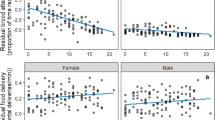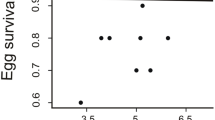Abstract
In monogamous bird species, male parental investment may influence offspring fitness and females may gain advantages through mating with males providing extensive paternal care. However, paternal care is a benefit that can only be assessed indirectly because mate choice precedes paternal activities. Individual quality and age, both signalled by morphological characteristics, may reflect parental abilities. Because they may reflect individual foraging abilities, carotenoid-based colorations have been proposed to honestly signal parental quality. The blackbird (Turdus merula), a socially monogamous species, exhibits biparental care and males show bills that vary from pale yellow to orange due to carotenoid pigments. In this study, we investigated whether male bill colour and age are associated with parental ability. Our results suggest that males with more orange bills and older males are better fathers. Indeed, male visit rate increased with their bill colour index independently of age, and brood condition was higher for adult males, compared to yearlings, independently of bill colour. Overall, the number of fledglings produced was positively influenced by both the age of males and the colour intensity of their bills. Males with more orange bills and adults had a greater number of fledglings and these males also had higher levels of prolactin, a hormone known to promote parental care. This latter finding suggests that prolactin may be the link between carotenoid based colorations and the intensity of paternal effort. Thus, male bill colour seems to honestly reveal male physiological adjustment to paternal activities.





Similar content being viewed by others
References
Agresti A (1990) Categorical Data Analysis. Wiley, New York
Andersson M (1994) Sexual Selection. Princeton University Press, Princeton
Bendich A (1993) Biological functions of Dietary Carotenoids. Ann NY Acad Sci 691:61–67
Bennett PM, Owens IPF (2002) Evolutionary ecology of birds: life histories, mating systems, and extinction. Oxford University Press, Oxford
Blount JD, Metcalfe NB, Birkhead TR, Surai PF (2003) Carotenoid modulation of immune function and sexual attractiveness in zebra finches. Science 300:125–127
Blount JD (2004) Carotenoids and life-history evolution in animals. Arch Biochem Biophys 430:10–15
Bright A, Waas JR (2002) Effects of bill pigmentation and UV reflectance during territory establishment in blackbirds. Anim Behav 64:207–213
Brooks R, Kemp DJ (2001) Can older males deliver the good genes? Trends Ecol Evol 16:308–313
Brush AH, Power DM (1976) House finch pigmentation: carotenoid metabolism and the effect of diet. Auk 93:725–739
Buntin JD (1996) Neural and hormonal control of parental behavior in birds. Adv Stud Behav 25:161–213
Burley NT (1983) The meaning of assortative mating. Ethol Sociobiol 4:191–203
Burley NT (1986) Sexual selection for aesthetic traits in species with biparental care. Am Nat 127:415–445
Burley NT (1988) The differential-allocation hypothesis: an experimental test. Am Nat 132:611–628
Burley NT, Johnson K (2002) The evolution of avian parental care. Phil Trans R Soc Lond B 357:241–250
Chamberlain DE, Hatchwell BJ, Perrins CM (1999) Importance of feeding ecology to the reproductive success of blackbirds Turdus merula nesting in rural habitats. Ibis 141:415–427
Clutton-Brock TH (1988) Reproductive Success. University of Chicago Press, Chicago
Clutton-Brock TH (1991) The Evolution of Parental Care. Princeton University Press, Princeton
Cramp S (1988) Birds of the western Palearctic, vol 5. Oxford University Press, Oxford
Creighton E (2000) Reproductive Strategies in the European Blackbird, Turdus merula. PhD thesis, Milton Keynes: The Open University
Dale J (2000) Ornamental plumage does not signal male quality in red-billed queleas. Proc R Soc Lond B 267:2143–2149
de Lope F, Møller AP (1993) Female reproductive effort depends on the degree of ornamentation of their mates. Evolution 47:1152–1160
Desrochers A (1992) Age and foraging success in European blackbirds: variation between and within individuals. Anim Behav 43:885–894
Desrochers A, Magrath RD (1996) Divorce in the European Blackbird: seeking greener pastures? In: Black JM (ed). Partnerships in birds. Oxford University Press, Oxford, pp 177–191
Deviche P, Wingfield JC, Sharp PJ (2000) Year-class differences in the reproductive system, plasma prolactin and corticosterone concentrations, and onset of prebasic molt in male Dark-eyed Juncos (Junco hyemalis) during the breeding period. Gen Comp Endocrinol 118:425–435
Duckworth R, Badyaev A, Parlow A (2003) Elaborately ornamented males avoid costly parental care in the house finch (Carpodacus mexicanus): a proximate perspective. Behav Ecol Sociobiol 55:176–183
Faivre B, Préault M, Théry M, Secondi J, Patris B, Cézilly F (2001) Breeding strategies and morphological characters in an urban population of blackbirds, Turdus merula. Anim Behav 61:969–974
Faivre B, Grégoire A, Préault M, Cézilly F, Sorci G (2003) Immune activation rapidly mirrored in a carotenoid-based secondary sexual trait. Science 300:103
Filliater TS, Breitwisch R (1997) Nestling provisioning by the extremely dichromatic northern cardinal. Wilson Bull 109:145–153
Forslund P, Pärt T (1995) Age and reproduction in birds-hypotheses and tests. Trends Ecol Evol 10:374–378
Fox DL, Vevers G (1960) The Nature of Animal Color. University of Washington Press, Seattle
Gray DA (1996) Carotenoids and sexual dichromatism in North American passerine birds. Am Nat 148:453–480
Hamilton WD, Zuk M (1982) Heritable true fitness and bright birds: a role for parasites? Science 218:384–387
Hatchwell BJ, Wood MJ, Ali Anwar M, Chamberlain DE, Perrins CM (2001) The haematozoan parasites of common Blackbirds Turdus merula: associations with host condition. Ibis 143:420–426
Hill GE (1991) Plumage coloration is a sexually selected indicator of male quality. Nature 350:337–339
Hill GE (1992) Proximate basis of variation in carotenoid pigmentation in male house finches. Auk 109:1–12
Hill GE (2002) A red bird in a brown bag: the function and evolution of colorful plumage in the House Finch. Oxford University Press, Oxford
Hoelzer GA (1989) The good parent process of sexual selection. Anim Behav 38:1067–1078
Hõrak P, Vellau H, Ots I, Møller AP (2000) Growth conditions affect carotenoid-based plumage coloration of great tit nestlings. Naturwissenschaften 87:460–464
Iwasa Y, Pomiankowski A (1999) Good parent and good genes models of handicap evolution. J Theor Biol 200:97–109
Keyser AJ, Hill GE (2000) Structurally based plumage coloration is an honest signal of quality in male blue grosbeaks. Behav Ecol 11:202–209
Ligon JD (1999) The Evolution of Avian Breeding Systems. Oxford University Press, Oxford
Linville SU, Breitwisch R (1997) Carotenoid availability and plumage coloration in a wild population of northern cardinals. Auk 114:796–800
Lormée H, Jouventin P, Chastel O, Mauget R (1999) Endocine correlates of parental care in an antarctic winter breeding seabird, the Emporor Penguin, Aptenodytes forsteri. Horm Behav 35:9–17
Lormée H, Jouventin P, Lacroix A, Lallemand J, Chastel O (2000) Reproductive endocrinology of tropical seabirds: sex-specific patterns in LH, steroids, and prolactin secretion in relation to parental care. Gen Comp Endocrinol 17:413–426
Lozano GA (1994) Carotenoids, parasites, and sexual selection. Oikos 70:309–311
Lozano GA (2001) Carotenoids, immunity, and sexual selection: comparing apples and oranges? Am Nat 158:200–203
Magrath RD (1992) The effect of egg mass on the growth and survival of blackbirds: a field experiment. J Zool Lond 227:639–653
Møller AP (1994) Sexual Selection and the Barn Swallow. Oxford University Press, Oxford
Møller AP, Biard C, Blound JD, Houston DC, Ninni P, Surai PF (2000) Carotenoïd-dependent signals: Indicators of foraging efficiency, immunocompetence or detoxification ability? Poult Avian Biol Rev 11:137–159
Morell V (1995) Zeroing in on how hormones affect immune system. Science 269:773–775
Murton RK, Westwood NJ (1977) Avian breeding cycles. Clarendon, Oxford
Norris K (1990) Female choice and quality of parental care in the great tit Parus major. Behav Ecol Sociobiol 27:275–281
Olson VA, Owens IPF (1998) Costly sexual signals: are carotenoids rare, risky or required? Trends Ecol Evol 13:510–514
Palokangas P, Korpimäki E, Hakkarainen H, Huhta E, Tolonen P, Alatalo RV (1994) Female kestrels gain reproductive success by choosing ornamented males. Anim Behav 47:443–448
Préault M, Deregnaucourt S, Sorci G, Faivre B (2002) Does beak coloration of male blackbirds play a role in intra and/or intersexual selection? Behav Process 58:91–96
Price T, Schluter D, Heckman NE (1993) Sexual selection when the female directly benefits. Biol J Linn Soc 48:187–211
Pryke SR, Lawes MJ, Andersson S (2001) Agonistic carotenoid signalling in male red-collared widowbirds: aggression related to the colour signal of both the territory owner and model intruder. Anim Behav 62:695–704
Rawles ME (1960) The integumentary system. In: Marshall AJ (ed). Biology and Comparative Physiology of Birds. Academic Press, New York, pp 189–240
Saetre GP, Fossnes T, Slagsvold T (1995) Food provisionning in the pied flycatcher: do female gain direct benefits from choosing bright-coloured males? J Anim Ecol 64:21–30
Sasvari L, Hegyi Z, Csörgö T, Hahn I (2000) Age-dependent diet change, parental care and reproductive cost in tawny owls Strix aluco. Acta Oecol 21:267–275
Schoech SJ, Mumme RL, Wingfield JC (1996) Prolactin and helping behaviour in the cooperatively breeding Florida scrub-jay, Aphelocoma c. coerulescens. Anim Behav 52:445–456
Searcy WA (1982) The evolutionary effects of mate selection. Annu Rev Ecol Syst 13:57–85
Senar JC, Escobar D (2002) Carotenoid derived plumage coloration in the siskin Carduelis spinus is related to foraging ability. Avian Sci 2:19–24
Senar JC, Figuerola J, Pascual J (2002) Brighter yellow blue tits make better parents. Proc R Soc Lond B 269:257–261
Shadd CA, Ritchison G (1998) Provisioning of nestlings by male and female yellow-breasted chats. Wilson Bull 110:398–402
Sheldon BC (2000) Differential allocation: tests, mechanism and implications. Trends Ecol Evol 15:397–402
Siefferman L, Hill GE (2003) Structural and melanin coloration indicate parental effort and reproductive success in male eastern bluebirds. Behav Ecol 14:855–861
Siegel S, Castellan NJ (1988) Nonparametric Statistics for the Behavioral Sciences. McGraw-Hill, New-York
Snow DW (1958) A Study of Blackbirds. Allen & Unwin, London
Sokal RR, Rohlf FJ (1995) Biometry. Freeman, New York
Sundberg J, Larsson C (1994) Male coloration as an indicator of parental quality in the yellowhammer Emberiza citrinella. Anim Behav 48:885–892
Svensson L (1992) Identification guide to european passerines. British Trust for Ornithology, Stockholm
Trivers RL (1972) Parental investment and sexual selection. In: Campbell B (ed). Sexual Selection and the Descent of Man,1871–1971. Heinemann, London, pp 136–179
Westneat DF, Sargent C (1996) Sex and parenting: the effects of sexual conflict and parentage on parental strategies. Trends Ecol Evol 11:87–91
Wolfenbarger L (1999) Red coloration of male northern cardinals correlates with male quality and territory quality. Behav Ecol 10:80–90
Woodard JD, Murphy MT (1999) Sex roles, parental experience and reproductive success of eastern kingbirds, Tyrannus tyrannus. Anim Behav 57:105–115
Acknowledgements
We thank the C.R.B.P.O., the ville de Dijon and Jardin Botanique de la ville de Dijon for permissions. This study was supported by the GDR CNRS 2155 “Ecologie Comportementale”. André Lacroix has done an invaluable technical work. We would like to thank Manuel Soler and the two anonymous referees for valuable comments that improved the mansucript. This work would not have been possible without technical assistance in the field from Mathias Barot, Romain Barot, Marco Barroca, Anne Besson, Claire Carvin, Claire Chalopin, Séverine Clair, Arnaud Grégoire, Luc Guillaume and Laurence Torcel. This work complies with French laws governing bird capture and experiments on animals
Author information
Authors and Affiliations
Corresponding author
Additional information
Communicated by M. Soler
Rights and permissions
About this article
Cite this article
Préault, M., Chastel, O., Cézilly, F. et al. Male bill colour and age are associated with parental abilities and breeding performance in blackbirds. Behav Ecol Sociobiol 58, 497–505 (2005). https://doi.org/10.1007/s00265-005-0937-3
Received:
Revised:
Accepted:
Published:
Issue Date:
DOI: https://doi.org/10.1007/s00265-005-0937-3




